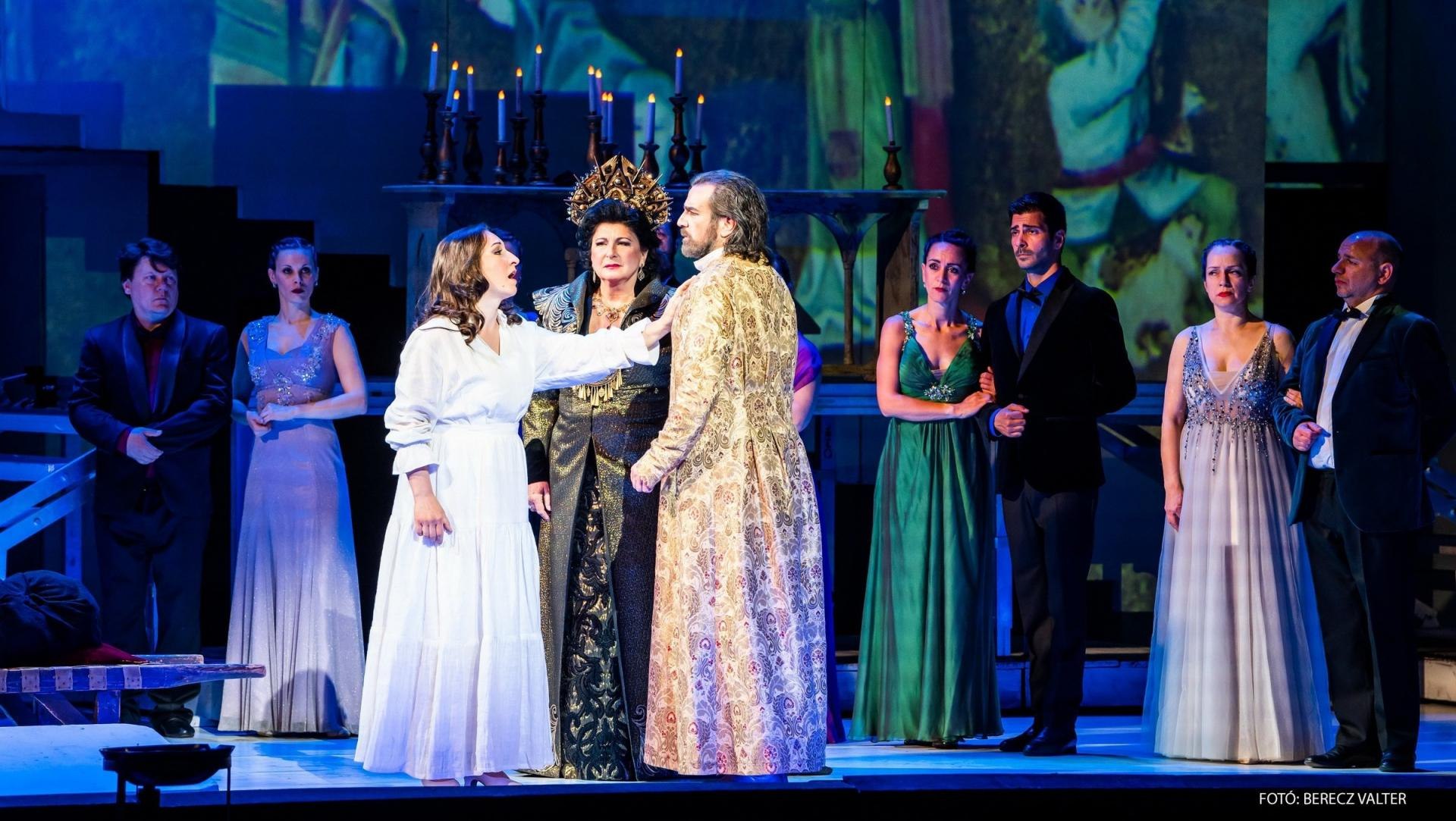Stephen, the King
Mo | Tu | We | Th | Fr | Sa | Su |
Stephen the King – Levente Szörényi, János Bródy | Symphonic version of rock opera
Running time" 2 hours 30 minutes, including one interval
Language: Hungarian
Surtitles: Hungarian, English
By far the most successful of the Hungarian crop of rock operas, ever since its original album release Stephen, the King has had not only symphonic features but has also been pervaded by the vocal, closed number structure characteristic of traditional operas, the presence of large tableaus, and instrumentation that gives the rock music universal perspectives. The poems for Levente Szörényi, who approached one of the fundamental stories in Hungarian history through Miklos Boldizsar’s play titled Ezredforduló (Turn of the Millennium), was written by his old co-author János Bródy. The Hungarian State Opera production staged the work with operatic instrumentation and opera singers in 2020. Thanks to the entirely symphonic score by composer Levente Gyöngyösi and the opera singers participating in the production, the work completely sheds the need for amplification, allowing new treasures to be discovered in the interpretation of Miklós Szinetár, the doyen of Hungarian directors. This production has been made possible through the mediation of the Zikkurat Stage Agency and Melody Kft.
Age restriction: The performance is not recommended for children under 8 years of age.
Synopsis
István, the son of Grand Prince Géza, and the Bavarian princess Gizella are married. The people pray for the couple. In the festive atmosphere, the three Hungarian lords Bese, Solt, and Sur are already fantasising about their future successes. Réka, the Christian daughter of Duke Koppány, is praying, asking for the conversion of the pagans, when she is interrupted by one of her father’s pagan men, Laborc, who rejects the new God. After the death of Géza, Koppány and István have a falling out at the funeral: Koppány had been hoping, to no avail, that Géza’s death would absolve the former promise of István inheriting the throne. The people ask for the peace of God, after which István and his mother Sarolt are entertained by folk musicians, which István finds to be overly old-fashioned. That’s when Laborc arrives at the scene. As a messenger from Koppány, he asks Sarolt to continue the ancient tradition of marrying him so they could rule together. Sarolt rejects the proposal and has Laborc executed. The three profit-seeking lords again show up, this time taking István’s side. However, he does not fall for their worthless flattery. After Sur, Solt, and Bese leave, István gives voice to his doubts, but Sarolt fills him with hope. Others are also dissatisfied: Gizella wants more from István as a husband, and the knight Vecellin wants more from him as a military leader. Asztrik, the head of the missionaries, appoints István Grand Prince. Duke Koppány and his shaman Torda address Koppány’s followers. His admirers Boglárka, Enikõ, and Picúr try to woo him, but the Duke resists. The three turncoat gentlemen arrive with the news that István has been appointed Grand Prince. They are now trying their luck by siding with Koppány, but he does not support them, either. Torda makes the most of the tension in the air, kindling the fire of the Duke’s belligerence and proceeding to make a sacrifice to the ancient gods. Réka tells her father about a nightmare she had, where she saw him quartered as a traitor. However, Koppány sees no solution than to take up the fight. István now arrives on scene and offers to hand over his power to Koppány on condition he turns to Rome, but Koppány does not accept the throne. Torda arrives with a bloody sword and a call to arms. In the battle, Koppány suffers a humiliating defeat. Women, elders, and children mourn the victims of the battle, the fight between two siblings. The victorious army celebrates István when Réka arrives to ask for her father’s body so she may bury him. István would be happy to fulfil the girl’s request, but Sarolt opposes her, and issues her command: “Quarter his body!” Koppány’s body is cut in four, and the people praise István. The Abbot Asztrik crowns István in the name of God, using the crown provided by the pope.
Program and cast
Conductor: Gergely Kesselyák
István - Zoltán Nyári, Barna Bartos
Sarolt - Andrea Ulbrich, Andrea Meláth
Gizella - Kinga Kriszta
Gizella - István Kovácsházi
Vecellin - Attila Dobák
Koppány - Csaba Szegedi
Torda - Boldizsár László
Laborc - János Szemenyei
Réka - Melinda Heiter, Vivienne Ortan (opera studio)
Bese - Tibor Szappanos
Solt - Botond Pál (opera studio)
Sur - András Kiss
First Narrator - Zoltán Bátki Fazekas
Second Narrator - István Kovácsházi
First bard - N. N.
Second bard - Gergely Ujvári
A mourner - László Szvétek
Shamaness - Lusine Sahakyan
Boglárka - Zsuzsanna Kapi
Enikő - Ildikó Megyimórecz
Picur - Zsófia Kálnay
Hont - Márió Matyó
Pázmány - Dávid Tarnai
Featuring the Orchestra, the Chorus and the Children's Chorus of the Hungarian State Opera
Director: Miklós Szinetár
Set designer: Balázs Horesnyi
Costume designer: Rita Velich
Choreographer: Bertalan Vári
Dramaturg: Eszter Orbán
English translation by Arthur Roger Crane
Video mapping: Limelight
Head of the Children’s Chorus: Nikolett Hajzer
Chorus director: Gábor Csiki
Hungarian State Opera
STANDING ROOM TICKETS - INFORMATION IN CASE OF A FULL HOUSE!
If all the seats are sold out for the selected time, but you still want to see the production on that day, 84 of the extremely affordable standing seats will be sold at the theatre, 2 hours before the start of the performance, with which you can visit the gallery on the 3rd floor. Tickets can be purchased at the ticket office of the Budapest Opera House. We would like to draw your attention to the fact that the stage can only be seen to a limited extent from the standing places and the side seats, but at the same time, following the performance is also supported by television broadcasting on the spot.
The Opera House is not only one of the most significant art relic of Budapest, but the symbol of the Hungarian operatic tradition of more than three hundred years as well. The long-awaited moment in Hungarian opera life arrived on September 27, 1884, when, in the presence of Franz Joseph I. the Opera House was opened amid great pomp and ceremony. The event, however, erupted into a small scandal - the curious crowd broke into the entrance hall and overran the security guards in order to catch a glimpse of the splendid Palace on Sugar út. Designed by Mikós Ybl, a major figure of 19th century Hungarian architecture, the construction lived up to the highest expectations. Ornamentation included paintings and sculptures by leading figures of Hungarian art of the time: Károly Lotz, Bertalan Székely, Mór Than and Alajos Stróbl. The great bronze chandelier from Mainz and the stage machinery moda by the Asphaleia company of Vienna were both considered as cutting-edge technology at that time.
Many important artists were guests here including Gustav Mahler, the composer who was director in Budapest from 1887 to 1891. He founded the international prestige of the institution, performing Wagner operas as well as Magcagni’ Cavalleria Rusticana. The Hungarian State Opera has always maintained high professional standards, inviting international stars like Renée Fleming, Cecilia Bartoli, Monserrat Caballé, Placido Domingo, Luciano Pavarotti, José Cura, Thomas Hampson and Juan Diego Flórez to perform on its stage. The Hungarian cast include outstanding and renowed artists like Éva Marton, Ilona Tokody, Andrea Rost, Dénes Gulyás, Attila Fekete and Gábor Bretz.

 EN
EN DE
DE IT
IT FR
FR ES
ES RU
RU JP
JP RO
RO
 Seating plan
Seating plan 